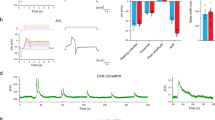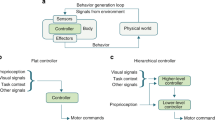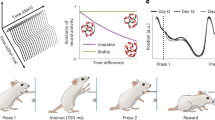Abstract
How neuronal networks enable animals, humans included, to make coordinated movements is a continuing goal of neuroscience research. The stomatogastric nervous system of decapod crustaceans, which contains a set of distinct but interacting motor circuits, has contributed significantly to the general principles guiding our present understanding of how rhythmic motor circuits operate at the cellular level. This results from a detailed documentation of the circuit dynamics underlying motor pattern generation in this system as well as its modulation by individual transmitters and neurons.
This is a preview of subscription content, access via your institution
Access options
Subscribe to this journal
Receive 51 print issues and online access
$199.00 per year
only $3.90 per issue
Buy this article
- Purchase on Springer Link
- Instant access to full article PDF
Prices may be subject to local taxes which are calculated during checkout





Similar content being viewed by others
References
Brown, T. G. On the nature of the fundamental activity of the nervous centres; together with an analysis of the conditioning of rhythmic activity in progression, and a theory of the evolution of function in the nervous system. J. Physiol. 48, 18–46 (1914).
Marder, E. & Calabrese, R. L. Principles of rhythmic motor pattern generation. Physiol. Rev. 76, 687–717 (1996).
Stein, P. S. G., Grillner, S., Selverston, A. I. & Stuart, D. G. (eds) Neurons, Networks, and Motor Behavior (The MIT Press, Cambridge, MA, 1997).
Marder, E. & Bucher, D. Central pattern generators and the control of rhythmic movements. Curr. Biol. 11, R986–R996 (2001).
Pearson, K. G. Neural adaptation in the generation of rhythmic behavior. Annu. Rev. Physiol. 62, 723–753 (2000).
McCormick, D. A. & Bal, T. Sleep and arousal: thalamocortical mechanisms. Annu. Rev. Neurosci. 20, 185–215 (1997).
Harris-Warrick, R. M., Marder, E., Selverston, A. I. & Moulins, M. (eds) Dynamic Biological Networks. The Stomatogastric Nervous System (MIT Press, Cambridge, MA, 1992).
Skiebe, P. Neuropeptides are ubiquitous chemical mediators: using the stomatogastric nervous system as a model system. J. Exp. Biol. 204, 2035–2048 (2001).
Turrigiano, G. G. & Heinzel, H.-G. in Dynamic Biological Networks: The Stomatogastric Nervous System (eds Harris-Warrick, R. M., Marder, E., Selverston, A. I. & Moulins, M.) 197–220 (MIT Press, Cambridge, MA, 1992).
Clemens, S., Combes, D., Meyrand, P. & Simmers, J. Long-term expression of two interacting motor pattern-generating networks in the stomatogastric system of freely behaving lobster. J. Neurophysiol. 79, 1396–1408 (1998).
Nusbaum, M. P., Blitz, D. M., Swensen, A. M., Wood, D. & Marder, E. The roles of co-transmission in neural network modulation. Trends Neurosci. 24, 146–154 (2001).
Heinzel, H. G., Weimann, J. M. & Marder, E. The behavioral repertoire of the gastric mill in the crab, Cancer pagurus: an in situ endoscopic and electrophysiological examination. J. Neurosci. 13, 1793–1803 (1993).
Weimann, J. M. & Marder, E. Switching neurons are integral members of multiple oscillatory networks. Curr. Biol. 4, 896–902 (1994).
Miller, J. P. in The Crustacean Stomatogastric System (eds Selverston, A. I. & Moulins, M.) 109–136 (Springer, Berlin, 1987).
Harris-Warrick, R. M., Nagy, F. & Nusbaum, M. P. in Dynamic Biological Networks: The Stomatogastric Nervous System (eds Harris-Warrick, R. M., Marder, E., Selverston, A. I. & Moulins, M.) 87–138 (MIT Press, Cambridge, MA, 1992).
Hartline, D. K. & Graubard, K. in Dynamic Biological Networks: The Stomatogastric Nervous System (eds Harris-Warrick, R. M., Marder, E., Selverston, A. I. & Moulins, M.) 31–86 (MIT Press, Cambridge, MA, 1992).
Hooper, S. L. & Marder, E. Modulation of the lobster pyloric rhythm by the peptide proctolin. J. Neurosci. 7, 2097–2112 (1987).
Ayali, A. & Harris-Warrick, R. M. Monoamine control of the pacemaker kernel and cycle frequency in the lobster pyloric network. J. Neurosci. 19, 6712–6722 (1999).
Sharp, A. A., O'Neil, M. B., Abbott, L. F. & Marder, E. The dynamic clamp: artificial conductances in biological neurons. Trends Neurosci. 16, 389–394 (1993).
Bartos, M., Manor, Y., Nadim, F., Marder, E. & Nusbaum, M. P. Coordination of fast and slow rhythmic neuronal circuits. J. Neurosci. 19, 6650–6660 (1999).
Swensen, A. M. & Marder, E. Modulators with convergent cellular actions elicit distinct circuit outputs. J. Neurosci. 21, 4050–4058 (2001).
Selverston, A. I., Kleindienst, H. U. & Huber, F. Synaptic connectivity between cricket auditory interneurons as studied by selective photoinactivation. J. Neurosci. 5, 1283–1292 (1985).
Warzecha, A. K., Egelhaaf, M. & Borst, A. Neural circuit tuning fly visual interneurons to motion of small objects. I. Dissection of the circuit by pharmacological and photoinactivation techniques. J. Neurophysiol. 69, 329–339 (1993).
Kemenes, G. & Elliott, C. J. Analysis of the feeding motor pattern in the pond snail, Lymnaea stagnalis: photoinactivation of axonally stained pattern-generating interneurons. J. Neurosci. 14, 153–166 (1994).
Ulrich, D. & Huguenard, J. R. GABAA-receptor-mediated rebound burst firing and burst shunting in thalamus. J. Neurophysiol. 78, 1748–1751 (1997).
Jaeger, D. & Bower, J. Synaptic control of spiking in cerebellar Purkinje cells: dynamic current clamp based on model conductances. J. Neurosci. 19, 6090–6101 (1999).
Kiehn, O., Kjaerulff, O., Tresch, M. C. & Harris-Warrick, R. Contributions of intrinsic motor neuron properties to the production of rhythmic motor output in the mammalian spinal cord. Brain Res. 53, 649–659 (2000).
Elson, R. C. & Selverston, A. I. Mechanisms of gastric rhythm generation in the isolated stomatogastric ganglion of spiny lobsters: bursting pacemaker potentials, synaptic interactions, and muscarinic modulation. J. Neurophysiol. 68, 890–907 (1992).
Coleman, M. J. & Nusbaum, M. P. Functional consequences of compartmentalization of synaptic input. J. Neurosci. 14, 6544–6552 (1994).
Combes, D., Meyrand, P. & Simmers, J. Dynamic restructuring of a rhythmic motor program by a single mechanoreceptor neuron in lobster. J. Neurosci. 19, 3620–3628 (1999).
Koshiya, N. & Smith, J. C. Neuronal pacemaker for breathing visualized in vitro. Nature 400, 360–363 (1999).
Parker, D. & Grillner, S. Neuronal mechanisms of synaptic and network plasticity in the lamprey spinal cord. Prog. Brain Res. 125, 381–398 (2000).
Thoby-Brisson, M. & Ramirez, J. M. Role of inspiratory pacemaker neurons in mediating the hypoxic response of the respiratory network in vitro. J. Neurosci. 20, 5858–5866 (2000).
Katz, P. S. & Harris-Warrick, R. M. Neuromodulation of the crab pyloric central pattern generator by serotonergic/cholinergic proprioceptive afferents. J. Neurosci. 10, 1495–1512 (1990).
Marder, E., Christie, A. E. & Kilman, V. L. Functional organization of cotransmission systems: lessons from small nervous systems. Invert. Neurosci. 1, 105–112 (1995).
Norris, B. J., Coleman, M. J. & Nusbaum, M. P. Pyloric motor pattern modification by a newly identified projection neuron in the crab stomatogastric nervous system. J. Neurophysiol. 75, 97–108 (1996).
Combes, D., Meyrand, P. & Simmers, J. Motor pattern specification by dual descending pathways to a lobster rhythm-generating network. J. Neurosci. 19, 3610–3619 (1999).
Morris, L. G., Thuma, J. B. & Hooper, S. L. Muscles express motor patterns of non-innervating neural networks by filtering broad-band input. Nature Neurosci. 3, 245–250 (2000).
Hooper, S. L. & Weaver, A. L. Motor neuron activity is often insufficient to predict motor response. Curr. Opin. Neurobiol. 10, 676–682 (2000).
Katz, P. S., Kirk, M. D. & Govind, C. K. Facilitation and depression at different branches of the same motor axon: evidence for presynaptic differences in release. J. Neurosci. 13, 3075–3089 (1993).
Jorge-Rivera, J. C., Sen, K., Birmingham, J. T., Abbott, L. F. & Marder, E. Temporal dynamics of convergent modulation at a crustacean neuromuscular junction. J. Neurophysiol. 80, 2559–2570 (1998).
Gutovitz, S., Birmingham, J. T., Luther, J. A., Simon, D. J. & Marder, E. GABA enhances transmission at an excitatory glutamatergic synapse. J. Neurosci. 21, 5935–5943 (2001).
Katz, P. S. & Tazaki, K. in Dynamic Biological Networks: The Stomatogastric Nervous System (eds Harris-Warrick, R. M., Marder, E., Selverston, A. I. & Moulins, M.) 221–262 (MIT Press, Cambridge, MA, 1992).
Katz, P. S. & Harris-Warrick, R. M. The evolution of neuronal circuits underlying species-specific behavior. Curr. Opin. Neurobiol. 9, 628–633 (1999).
Meyrand, P., Faumont, S., Simmers, J., Christie, A. E. & Nusbaum, M. P. Species-specific modulation of pattern-generating circuits. Eur. J. Neurosci. 12, 2585–2596 (2000).
Meyrand, P., Simmers, J. & Moulins, M. Dynamic construction of a neural network from multiple pattern generators in the lobster stomatogastric nervous system. J. Neurosci. 14, 630–644 (1994).
Marder, E. & Hooper, S. L. in Model Neural Networks and Behavior (ed. Selverston, A. I.) 319–337 (Plenum, New York, 1985).
Tierney, A. J. & Harris-Warrick, R. M. Physiological role of the transient potassium current in the pyloric circuit of the lobster stomatogastric ganglion. J. Neurophysiol. 67, 599–609 (1992).
Elson, R. C., Huerta, R., Abarbanel, H. D., Rabinovich, M. I. & Selverston, A. I. Dynamic control of irregular bursting in an identified neuron of an oscillatory circuit. J. Neurophysiol. 82, 115–122 (1999).
Hooper, S. L. Phase maintenance in the pyloric pattern of the lobster (Panulirus interruptus) stomatogastric ganglion. J. Comput. Neurosci. 4, 191–205 (1997).
Harris-Warrick, R. M. & Flamm, R. E. Multiple mechanisms of bursting in a conditional bursting neuron. J. Neurosci. 7, 2113–2128 (1987).
Baro, D. J. & Harris-Warrick, R. M. Differential expression and targeting of K+ channel genes in the lobster pyloric central pattern generator. Ann. NY Acad. Sci. 860, 281–295 (1998).
Baro, D. J. et al. Molecular underpinnings of motor pattern generation: differential targeting of shal and shaker in the pyloric motor system. J. Neurosci. 20, 6619–6630 (2000).
Kloppenburg, P., Zipfel, W. R., Webb, W. W. & Harris-Warrick, R. M. Highly localized Ca2+ accumulation revealed by multiphoton microscopy in an identified motoneuron and its modulation by dopamine. J. Neurosci. 20, 2523–2533 (2000).
Reyes, A. Influence of dendritic conductances on the input-output properties of neurons. Annu. Rev. Neurosci. 24, 653–675 (2001).
Harris-Warrick, R. M. et al. Distributed effects of dopamine modulation in the crustacean pyloric network. Ann. NY Acad. Sci. 860, 155–167 (1998).
Goldman, M. S., Golowasch, J., Marder, E. & Abbott, L. F. Global structure, robustness, and modulation of neuronal models. J. Neurosci. 21, 5229–5238 (2001).
Hooper, S. L. Transduction of temporal patterns by single neurons. Nature Neurosci. 1, 720–726 (1998).
Soto-Treviño, C., Thoroughman, K. A., Marder, E. & Abbott, L. F. Activity-dependent modification of inhibitory synapses in models of rhythmic neural networks. Nature Neurosci. 4, 297–303 (2000).
Selverston, A. I. et al. Reliable circuits from irregular neurons: a dynamical approach to understanding central pattern generators. J. Physiol. Paris 94, 357–374 (2000).
Marder, E. et al. Physiological insights from cellular and network models of the stomatogastric nervous systems of lobsters and crabs. Am. Zool. 33, 29–39 (1993).
Nadim, F., Manor, Y., Nusbaum, M. P. & Marder, E. Frequency regulation of a slow rhythm by a fast periodic input. J. Neurosci. 18, 5053–5067 (1998).
Edwards, D. H., Yeh, S. R. & Krasne, F. B. Neuronal coincidence detection by voltage-sensitive electrical synapses. Proc. Natl Acad. Sci. USA 95, 7145–7150 (1998).
Perez-Velazquez, J. L. & Carlen, P. L. Gap junctions, synchrony and seizures. Trends Neurosci. 23, 68–74 (2000).
Galarreta, M. & Hestrin, S. Electrical synapses between GABA-releasing interneurons. Nature Rev. Neurosci. 2, 425–433 (2001).
Schmitz, D. et al. Axo-axonal coupling: a novel mechanism for ultrafast neuronal communication. Neuron 31, 831–840 (2001).
Marder, E. Roles for electrical coupling in neural circuits as revealed by selective neuronal deletions. J. Exp. Biol. 112, 147–167 (1984).
Kiehn, O. & Tresch, M. C. Gap junctions and motor behavior. Trends Neurosci. 25, 108–115 (2002).
Graubard, K. & Hartline, D. K. Full-wave rectification from a mixed electrical-chemical synapse. Science 237, 535–537 (1987).
Johnson, B. R., Peck, J. H. & Harris-Warrick, R. M. Differential modulation of chemical and electrical components of mixed synapses in the lobster stomatogastric ganglion. J. Comp. Physiol. A 175, 233–249 (1994).
Coleman, M. J., Meyrand, P. & Nusbaum, M. P. A switch between two modes of synaptic transmission mediated by presynaptic inhibition. Nature 378, 502–505 (1995).
Nadim, F. & Manor, Y. The role of short-term synaptic dynamics in motor control. Curr. Opin. Neurobiol. 10, 683–690 (2000).
Parker, D. & Grillner, S. Activity-dependent metaplasticity of inhibitory and excitatory synaptic transmission in the lamprey spinal cord locomotor network. J. Neurosci. 19, 1647–1656 (1999).
Manor, Y. & Nadim, F. Synaptic depression mediates bistability in neuronal networks with recurrent inhibitory connectivity. J. Neurosci. 21, 9460–9470 (2001).
Turrigiano, G. Homeostatic plasticity in neuronal networks: the more things change, the more they stay the same. Trends Neurosci. 22, 221–217 (1999).
Turrigiano, G. G. & Nelson, S. B. Hebb and homeostasis in neuronal plasticity. Curr. Opin. Neurobiol. 10, 358–364 (2000).
Turrigiano, G. G., LeMasson, G. & Marder, E. Selective regulation of current densities underlies spontaneous changes in the activity of cultured neurons. J. Neurosci. 15, 3640–3652 (1995).
Mizrahi, A. et al. Long-term maintenance of channel distribution in a central pattern generator neuron by neuromodulatory inputs revealed by decentralization in organ culture. J. Neurosci. 21, 7331–7339 (2001).
Bartos, M. & Nusbaum, M. P. Intercircuit control of motor pattern modulation by presynaptic inhibition. J. Neurosci. 17, 2247–2256 (1997).
Kawahara, K., Kumagai, S., Nakazono, Y. & Myamoto, Y. Coupling between respiratory and stepping rhythms during locomotion in decerebrate cats. J. Appl. Physiol. 67, 110–115 (1989).
Larson, C. R., Yajima, Y. & Ko, P. Modification of activity of medullary respiratory-related neurons for vocalizing and swallowing. J. Neurophysiol. 71, 2294–2304 (1994).
Marder, E. & Meyrand, M. in Neuronal and Cellular Oscillators (ed. Jacklet, J.) 317–338 (Dekker, New York, 1989).
Meyrand, P., Simmers, J. & Moulins, M. Construction of a pattern-generating circuit with neurons of different networks. Nature 351, 60–63 (1991).
Hooper, S. L. & Moulins, M. Cellular and synaptic mechanisms responsible for a long-lasting restructuring of the lobster pyloric network. J. Neurophysiol. 64, 1574–1589 (1990).
Soffe, S. R. Two distinct rhythmic motor patterns are driven by common premotor and motor neurons in a simple vertebrate spinal cord. J. Neurosci. 13, 4456–4469 (1993).
Earhart, G. M. & Stein, P. S. G. Step, swim and scratch motor patterns in the turtle. J. Neurophysiol. 84, 2181–2190 (2000).
Lieske, S. P., Thoby-Brisson, M., Telgkamp, P. & Ramirez, J. M. Reconfiguration of the neural network controlling multiple breathing patterns: eupnea, sighs and gasps. Nature Neurosci. 3, 600–607 (2000).
Dickinson, P. S., Mecsas, C. & Marder, E. Neuropeptide fusion of two motor-pattern generator circuits. Nature 344, 155–158 (1990).
Scholz, N. L., de Vente, J., Truman, J. W. & Graubard, K. Neural network partitioning by NO and cGMP. J. Neurosci. 21, 1610–1618 (2001).
Hemple, C. M., Vincent, P., Adams, S. R., Tsien, R. Y. & Selverston, A. I. Spatio-temporal dynamics of cyclic AMP signals in an intact neural circuit. Nature 384, 166–169 (1996).
Swensen, A. M. & Marder, E. Multiple peptides converge to activate the same voltage-dependent current in a central pattern-generating circuit. J. Neurosci. 20, 6752–6759 (2000).
Marder, E. & Calabrese, R. L. Principles of rhythmic motor pattern generation. Physiol. Rev. 76, 687–717 (1996).
Nagy, F. & Cardi, P. A rhythmic modulatory gating system in the stomatogastric nervous system of Homarus gammarus. II. Modulatory control of the pyloric CPG. J. Neurophysiol. 71, 2490–2502 (1994).
Perrins, R. & Weiss, K. R. Compartmentalization of information processing in an aplysia feeding circuit interneuron through membrane properties and synaptic interactions. J. Neurosci. 18, 3977–3989 (1998).
Wood, D. E., Stein, W. & Nusbaum, M. P. Projection neurons with shared cotransmitters elicit different motor patterns from the same neural circuit. J. Neurosci. 20, 8943–8953 (2000).
Wood, D. E. & Nusbaum, M. P. Extracellular peptidase activity tunes motor pattern modulation. J. Neurosci. 22, 4185–4195 (2002).
Richards, K. S. & Marder, E. The actions of crustacean cardioactive peptide on adult and developing stomatogastric ganglion motor patterns. J. Neurobiol. 44, 31–44 (2000).
Le Feuvre, Y., Fenelon, V. S. & Meyrand, P. Ontogeny of modulatory inputs to motor networks: early established projection and progressive neurotransmitter acquisition. J. Neurosci. 21, 1313–1326 (2001).
O'Donovan, M. J. The origin of spontaneous activity in developing networks of the vertebrate nervous system. Curr. Opin. Neurobiol. 9, 94–104 (1999).
Wong, R. O. L. Retinal waves and visual system development. Annu. Rev. Neurosci. 22, 29–47 (1999).
Acknowledgements
We thank E. Marder for his helpful discussions and R. Harris-Warrick for feedback on an earlier version of the manuscript. Research support in our laboratory is from National Institute of Neurological disorders and Stroke grants.
Author information
Authors and Affiliations
Corresponding author
Rights and permissions
About this article
Cite this article
Nusbaum, M., Beenhakker, M. A small-systems approach to motor pattern generation. Nature 417, 343–350 (2002). https://doi.org/10.1038/417343a
Issue Date:
DOI: https://doi.org/10.1038/417343a
This article is cited by
-
Modeling brain, symptom, and behavior in the winds of change
Neuropsychopharmacology (2021)
-
Dynamic representations in networked neural systems
Nature Neuroscience (2020)
-
Angiotensin II induces coordinated calcium bursts in aldosterone-producing adrenal rosettes
Nature Communications (2020)
-
Feedforward discharges couple the singing central pattern generator and ventilation central pattern generator in the cricket abdominal central nervous system
Journal of Comparative Physiology A (2019)
-
The dark matter of the brain
Brain Structure and Function (2019)
Comments
By submitting a comment you agree to abide by our Terms and Community Guidelines. If you find something abusive or that does not comply with our terms or guidelines please flag it as inappropriate.



